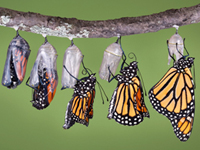

 |

|
 Monarch Butterfly |
Monarch Butterfly(Insect) |
 Monarch Butterfly Baby |
Monarch Butterfly HabitsDespite its paper-thin wings. the monarch butterfly is a powerful flyer with uncanny endurance. It is best known for its annual migration through-sometimes as far as 3000 miles-North America to California and Mexico. Monarch Butterflies that breed in the temperate parts of North America migrate so that their eggs and caterpillars won't be killed by prolonged winter frost. For this reason, the autumn monarch broods are more likely to migrate than those that are hatched during the warm spring weather.
The 5 million monarch butterflies from western North America head for a small number of sites scattered along the coast of California. The 100 million butterflies from the eastern part of the country head south to Michoacan in Central Mexico.
During the last 200 years, the monarch butterfly has also succeeded in colonizing places as far away as Hawaii, Fiji, Australis, and New Zealand. These tropical monarch butterflies tend to be less mobile than their relatives in the temperate zones, seldom needing to travel far from their warm habitat.
The crowded winter roosts of the monarch butterfly are one of the natural wonders of the world. In Mexico, the roosting sites of the eastern monarch butterfly consist of a small area of pine forest. As many as 15 million orange and black butterflies cover the trees at one time. The temperature of the roost should be just above freezing. If it is too cold, the butterflies will die; if it is too warm, they will wake up and expend valuable energy. |
Monarch Butterfly CommunicationThere is a great deal we have to learn about how monarchs communicate. We know that at roosting sites they communicate through their coloration--by opening and closing their wings, they seem to be saying, "Don't land on me". It is also suspected that the male monarchs communicate with the female monarchs by emitting a scent, referred to as a "pheromone." In a famous experiment, Dr. Fred Urquhart placed twenty living monarchs in fine nylon bags and hid them behind clusters of leaves on the branches of trees. Within 20 minutes, free-flying migrants approached the trees, with some resting on neighbouring branches. A few flew into the cluster of leaves to come to rest on the nylon bags. He concluded that monarch butterflies do communicate in some unknown manner. |
Monarch Butterfly BreedingIn early spring monarch butterflies come out of hibernation and begin their migration north.
Many stop to mate and lay their eggs on milkweed plants. The eggs hatch into caterpillars within a few days. After the caterpillars pupate and become butterflies a month later, they also join the northward flight.
During the flight, the newly-adult butterflies may also stop to breed. Up to five generations of monarch butterflies may migrate in one season. All monarch butterflies congregate at specific winter roost sites in California and Mexico.
Monarch courtship is unusual among the Lepidoptera in that males sometimes force females to copulate and appear not to use chemical courtship like most other butterflies and moths do. Males initiate mating attempts by pursuing females in the air, often forcing them to the ground and engaging in a long ground struggle. The male probes the female with the tip of his abdomen while the female appears to resist. About 30% of these mating attempts end in copulation; when it does, the male successfully attaches the end of his abdomen to the slit that you can see in the bottom of the females abdomen. Both females and males often mate several times during their lifetimes. |
Monarch Butterfly Food & FeedingThe monarch butterfly is found throughout North and South America wherever the milkweed plant grows. The monarch larvae feed on various types of milkweed, which thrives in open spaces, as well as beside roads, along woodland edges, on empty lots, and in overgrazed pastures. Anywhere milkweed grows, monarchs thrive. |
Monarch Butterfly Key Facts |
| Size |
| Height: Wingspan: 3 inches |
| Weight: 1/2 ounce |
| Breeding |
| Sexual maturity: 3-4 weeks |
| Mating: Year round |
| Gestation: Hatching time:3-4 days |
| Number of young: Average is about 700 |
| Lifestyle |
| Habit: Fly in groups |
| Diet: Larvae feed on milkweed; adults feed on flower nectar |
| Lifespan: 3-4 weeks in summer generations; 7-8 months in over-wintered generations |
DID YOU KNOW?
|
CAN'T FIND WHAT YOU'RE LOOKING FOR? CLICK HERE!!!